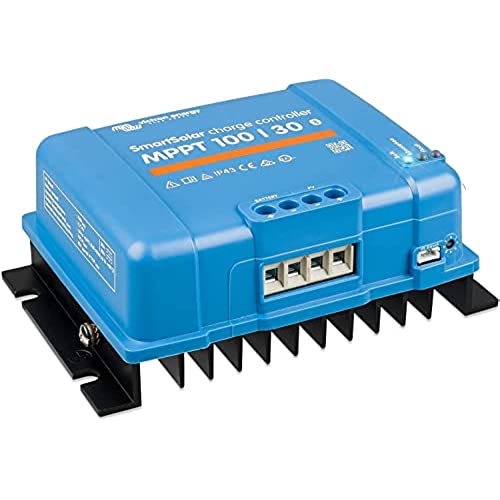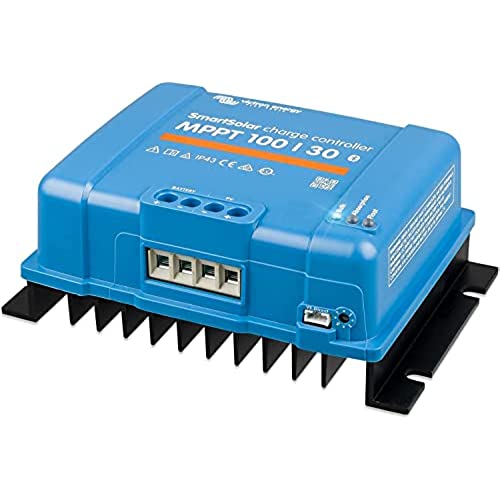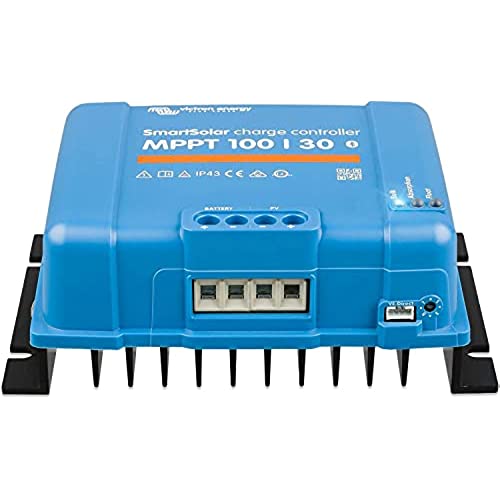









Victron Energy SmartSolar MPPT 100V 30 amp 12/24-Volt Solar Charge Controller (Bluetooth)
-

Laurel
> 3 dayDoes a great job regulating the battery power on our RV’s solar setup.
-

Doug T.
> 3 dayNot much to say. It works as advertised is is very high quality. Well worth the money. I will be buying more Victron products.
-

MPH=CA
> 3 dayDue to the wiring nightmare to make it work between the trailer and truck.
-

Sourdo
> 3 dayI recently installed two 100 watt Renogy solar panels on top of my RV trailer, along with a Renogy 30 amp PWM controller with a bluetooth dongle. The panels work fine, the Renogy SCC (Solar Charge Controller) not so fine. The bluetooth app is broken, crashes frequently, and is mostly a waste of money. While the Renogy SCC did its job, the performance on cloudy/shaded days was inadequate. With a PWM SCC, you must run your panels in parallel. You cannot fully charge a battery with 13 volts available (cloudy day in trees) from the PWM SCC, no matter what the amps is. With the panels in series, that 13 volts would now be 26 volts. So I ordered the Victron SmartSolar 75/15 MPPT controller with built in Bluetooth. With an MPPT controller, you have the option to run your panels in series or parallel. Running my panels in series doubles available voltage (up to around 40 volts, which the SCC converts excess voltage to the appropriate voltage (12 or 24 volts) and current (amps) to charge your batteries. This SCC handles this nicely. The unit was delivered in brand new condition. I was surprised how small it is. There are three LED indicator lights on the front. You cannot flush mount this device. I installed this inside a wall with a vent pipe, and ran my wires out the top of the RV via the vent exit. Where I mounted inside the wall, I used a tin lid against the wood. The instructions say to mount the unit on a non-combustible surface. I stacked two washers between the wall and tin, offering a better way to dissipate heat from the back of the device. If you look closely at the picture, you can see what I did. Then I made a facade cover with a small peep hole to quick view the LEDs. These LEDs are quite bright, some people tape over them. I would try a black felt tip marker to try and dim things first. There is no way to flush mount this unit. You cannot use wire bigger than 10 AWG. Some claim 10 AWG is too big, but that just isnt so. Just dont mangle the wire ends and theyll fit. But there is a better way, read below. What I do is to tin the wire ends. Strip off 1/2 inch of wire, give a slight twist to keep the strands tight. With a good soldering iron, solder the wire end, making sure the solder flows evenly. Not too much or youll end up with a fat end that wont fit in the lugs. You might practice this with a piece of wire, but once done correctly you have a superior connection. Then after inserting the end into the lug, tighten snuggly, then loosen, the re-tighten. Each time the lug will screw down a little tighter as the lug worms into the wire end. Ill do this at least 10-15 times, until the lug is snug and secure. Be careful to not over tighten and strip the lug. Use cable restraints. Once the battery is connected, hook up the PV array. I cover my solar panels with some plywood (or some cardboard) to turn down the open voltages while I connected those, which for two 100 watt panels in series is over 40 volts in bright sun and could shock you. I also installed a disconnect switch for the PV panels, next to that is the inverter remote switch. Your battery must be connected first, then connect the PV array. The one weak area of this device is the manual. It comes with a tiny booklet that is difficult to read. You can download the PDF version from Victrons website. Some of the info is sketchy and in not so plain English. For some info you need to install another app called Victron Toolkit. This offers explanations of the various blinking LED functions. The built in Bluetooth requires an app called Victron Connect(I have an Android Nokia smartphone) for reading power outputs, managing battery charging profiles, etc. The app was downloaded and installed without issue. With the app installed and paired to my phone, the app quickly upgraded the firmware for the SCC. Once this was done, the app works very well. I can walk about 40 feet away and can still stay connected, which is about normal for Bluetooth devices. Again, the app is well done and works well. The manual has some odd English to explain some of the functions. Ill try to explain in plain English as I see it. When you first hook up the SCC, the manual says 5+ volts from the PV panels over the Battery volts is needed to be operational (According to the manual). I would expect the unit to be operational when I bought it brand new out of the box. What this really means is this; When the controller sees 5 or more volts from the PV (solar panels) above the battery volts, it turns on the charger. When the PV volts drops to 1 volt or less then the battery volts, it turns off the charger. You can tell if the SCC is on and charging with a steady blue(or yellow or green, depending on SOC(State Of Charge)) LED, or off with a blinking blue LED every 2-3 seconds. When not charging, you can still use the Bluetooth. As the day progresses the LEDs will turn to yellow (absorption mode) to green (float mode) depending on clouds and trees, and of course electrical use. With my panels hooked up in series, mine starts up right about the crack of dawn and is charging in bulk mode with a steady blue LED. With the ability to turn off charging, I have notice right off my battery is still > 80% SOC (state of charge) when it restarts in the morning, even with the propane sensor on (my only parasitic load when parked). I like the Bluetooth app. It gives you complete control over battery settings and you can use just about any type of battery including lithium. The app also has a handy history function that is very useful. Some people complain about the range of communication with the Bluetooth. Mine functions like any Bluetooth, about 40 feet of range and that is that. Even with the SCC inside a tin covered RV and me outside, it works fine. I hope someone reads this before going with a PWM charger. For a few more bucks you can have a superior solar system. But for the somewhat lacking manual, I have no cons for this device. I have also ordered the Bluetooth battery temperature and voltage monitoring device for better charging. My batteries are outside the RV while the SCC is inside, this can skew charging parameters. https://www.amazon.com/gp/product/B07RTYGMBD/ref=ppx_yo_dt_b_asin_title_o01_s00?ie=UTF8&psc=1 I use two Duracell 78 ah AGM Ultra group 24 batteries along with a 1200/2400 watt inverter, so far this is working out well. This device has load outputs. For the average RV person setting up a simple solar system, this can be ignored. Run your 12 volts supply from the battery as it was originally wired. UPDATE July 1st, 2021: I have recently added two more Renogy 100 watt compact solar panes to the other two, making a total of four. To get these to work on the Victron 75/15 Smartsolar charger, I created two groups of two panels in series, then connected the two groups in parallel. Any other way would be over the rated amps or volts (depending on how the panels are connected. This setup delivers to the battery 15 amps @ 13.6 volts (float), which is as high as it can go. Volts remain the same as the original setup with two panels in series, about 43 volts. I just get double the amps. If I want to get the maximum amps I need to buy the next size up, the MPPT 100/20 controller. As it is now with four 100 watt panels, the charge controller works very well. With 4 panels connected, it turns on quite a bit before sunrise. The extra panels are very helpful in shade or cloudy days(or both). And when the sun shines, the output is strong.
-

Chris Mack
> 3 dayI have this on a small pico hydro unit and it works well. the app is nice, its easy to use. 4 stars, not 5 because the bluetooth connection, while good, limits the usefulness of the app, would be better on wifi, and because its somewhat limiting in what you can do with it, and limited configuration without buying a bunch of other victron equipment, but if all you need is a plug and play small controller, this one is nice, its super small, looks good, and works well.
-

Prof. Rosendo Blick Jr.
> 3 dayAfter purchasing a 26$ controller, which seemed to work okay, I decided to upgrade to a bit more professional controller for my simple solar solution so I could have a better view of what was really happening with my 400 watts of solar panels dumping to 2 marine deep cycle batteries. This unit is everything that I expected and much more. The bluetooth interface is amazing. 26$ will get you a charge controller and most likely it will work but with the bluetooth interface (iPhone, IPad, and Mac) on the Victron, I can watch this one work real time along with built in trending. It keeps track of my power generation daily with bar graphs showing peak Watts and Volts per day along with battery charge max and min. I can see, while writing this, I am currently making 301 watts and have been generating for 3h 43m in bulk mode loading the batteries. For me, that is worth the extra money and 5 stars for Victron for making a product that is easy to use and very stable. NOTE: Make sure you size it right. Many different models to chose from to fit your solar size.
-

Sam Horowitz
> 3 dayI was using an EPEVER MPPT solar charge controller with similar specifications. OMG this controller is SO MUCH BETTER at calculating the maximum power point! In the last 5 days, Ive already generated HALF of what I generated with the EPEVER, which I had and used for 2 full months! Even in similar cloudy conditions I am generating so much more power! The built in Bluetooth function is super easy to set up. I used my android to configure it. I had it up and running in no joke, 5 minutes! I will CERTAINLY be buying more products from Victron!!
-

Luke Underwood
> 3 dayThe Software Is Awesome and Gives So Much Detail On My Tablet. The one problem is that my tablet is only about 15-20 feet away from the controller and it sill loses signal so often, even with the doors open and no major interference. Ive seen other reviewers mention the same issue.
-

M. Dillon
> 3 dayThe 75-15 units work great and stay cool under full load. They work as advertised. That said, the 15A output limit doesnt give you much at 12V (200W) or 24V (400W) (my battery system is 24V LFP), and I made the mistake of undersizing the charge controller against my solar which runs 500W+ in full sun. Hence why I was able to make the comment about them staying cool under full load :-). So I recommend buying the SmartSolar MPPT 100-20 instead of the 75-15. The price point is still very good and those 5 extra amps can make a difference. Plus the 75-15 is limited to 24V battery systems while the 100-20 gives you the flexibility to move to a more powerful 48V battery system in the future. I also have two 100-20s. When maxed out at 20A they generally clock in at 60C and dont go much higher, so not as cool as the 75-15s. But the 100-20s are far more capable, and can handle 12/24/48V without issue. A low speed fan is all it takes to keep them in a nice comfort zone while pushing 20A to the battery. Im running 70V VOC and 80V VOC (roughly) strings with no issues into these controllers, so the input amps and losses are very low. Thus the charge controllers are limited only by the output amps. The control and programming features are great. Ive used the load output directly and the virtual load output (basically a relay control output) as well. There are a few quirks with the direct load output, it cant handle surges at all really, even short ones. The battery profile is completely customizable and output amps can be limited. I actually used one of my 75-15 charge controllers as a high-efficiency level shifter going from a 24V battery to a small 12V battery at one point using the customization to limit the current. -- It would be nice if the load output could handle more current and capacitive inflow currents on start. I have used the load output on 24V systems at around 15A without issue driving resistive loads. But just like the Victron battery-protect stuff, these FET-switched load outputs cheap-out on components and just arent very capable despite the rating. It would be nice if Victron could improve on them but I wont subtract a star since it isnt really the primary function for the charge controller and the virtual-load output works quite well. In fact, one can use the actual load output to switch certain other FET power switches, (or relays, or contactors) very quickly since they are capable of decent gate currents verses VE TX port. So there is versatility here that I like.
-

Ken
> 3 dayThis product has performed flawlessly on a 300 watt (3 x 100 watt panels) solar system into a 24 vdc battery. Initially started with using 200 watt (2 x 100 watt panels) solar system with a 12 vdc lithium battery before upgrading to the 24 vdc batteries (2 12 vdc batteries in parallel) to allow for the extra 100 watt solar panel. Panels are connected in series and the victron mppt handles it flawlessly.
